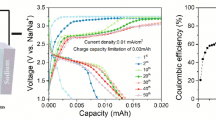Abstract
Li-ion batteries are a key technology for multiple clean energy applications. In this study, Cu2O nanowires were obtained by the reduction of cupric acetate with pyrrole. The resulting Cu2O nanowires exhibited excellent reversible capacities of 470 mAh g−1 at rate of 1 C after 100 cycles. The results show that the Cu2O nanowires had more capacity than materials previously reported. No fading was observed over 100 cycles of charging and discharging. The compound metal Cu and incorporation of the conducting polymer polypyrrole (PPy) improved the conductivity of Cu2O and enhanced the stability of the electrode during cycling. The results from this study imply that Cu2O nanowires with high capacity and good cycle retention could be excellent candidates as anode materials for Li-ion rechargeable batteries.
Similar content being viewed by others
References
Poizot P, Laruelle S, Grugeon S, et al. Nano-sized transition-metal oxides as negative-electrode materials for lithium-ion batteries. Nature, 2000, 407: 496–499
Hasan M, Chowdhury T, Rohan J F, Nanotubes of core/shell Cu/Cu2O as anode materials for Li-ion rechargeable batteries. J Electrochem Soc, 2010, 157: A682–A688
Idota Y, Kubota T, Matsufuji A, et al. Tin-based amorphous oxide: A high-capacity lithium-ion-storage material. Science, 1997, 276: 1395–1397
Fu Z W, Huang F, Zhang Y, et al. The electrochemical reaction of zinc oxide thin films with lithium. J Electrochem Soc, 2003, 150: A714–A720
Megahed S, Scrosati B, Lithium-ion rechargeable batteries. J Power Sources, 1994, 51: 79–104
Grugeon S, Laruelle S, Herrera-Urbina R, et al. Particle size effects on the electrochemical performance of copper oxides toward lithium. J Electrochem Soc, 2001, 148: A285–A292
Zhang C Q, Tu J P, Huang X H, et al. Preparation and electrochemical performances of cubic shape Cu2O as anode material for lithium ion batteries. J Alloys Comp, 2007, 441: 52–56
Ng C H B, Fan W Y. Shape evolution of Cu2O nanostructures via kinetic and thermodynamic controlled growth. J Phys Chem B, 2006, 110: 20801–20807
Mai Y J, Wang X L, Xiang J Y, et al. CuO/graphene composite as anode materials for lithium-ion batteries. Electrochim Acta, 2011, 56: 2306–2311
Jung H R, Cho S J, Kim K N, et al. Electrochemical properties of electrospun Cu(x)O (x=1, 2)-embedded carbon nanofiber with EXAFS analysis. Electrochim Acta, 2011, 56: 6722–6731
Zhang Y, Wang X, Zeng L, et al. Green and controlled synthesis of Cu2O-graphene hierarchical nanohybrids as high-performance anode materials for lithium-ion batteries via an ultrasound assisted approach. Dalton Trans, 2012, 41: 4316–4319
Boyano I, Blazquez J A, de Meatza I, et al. Preparation of C-LiFePO4/polypyrrole lithium rechargeable cathode by consecutive potential steps electrodeposition. J Power Sources, 2010, 195: 5351–5359
Kim Y, Kim J S, Thieu M T, et al. Increase in discharge capacity of Li battery assembled with electrochemically prepared V2O5/poly-pyrrole-composite-film cathode. Bull Korean Chem Soc, 2010, 31: 3109–3114
Yin Z, Ding Y, Zheng Q, et al. CuO/polypyrrole core-shell nanocomposites as anode materials for lithium-ion batteries. Electrochem Comm, 2012, 20: 40–43
Tan Y W, Xue X Y, Peng Q, et al. Controllable fabrication and electrical performance of single crystalline Cu2O nanowires with high aspect ratios. Nano Lett, 2007, 7: 3723–3728
Lee Y H, Leu I C, Chang S T, et al. The electrochemical capacities and cycle retention of electrochemically deposited Cu2O thin film toward lithium. Electrochim Acta, 2004, 50: 553–559
Author information
Authors and Affiliations
Corresponding author
Rights and permissions
About this article
Cite this article
Chen, R., Wang, Y., Nuli, Y. et al. Cu2O nanowires as anode materials for Li-ion rechargeable batteries. Sci. China Technol. Sci. 57, 1073–1076 (2014). https://doi.org/10.1007/s11431-014-5509-1
Received:
Accepted:
Published:
Issue Date:
DOI: https://doi.org/10.1007/s11431-014-5509-1




